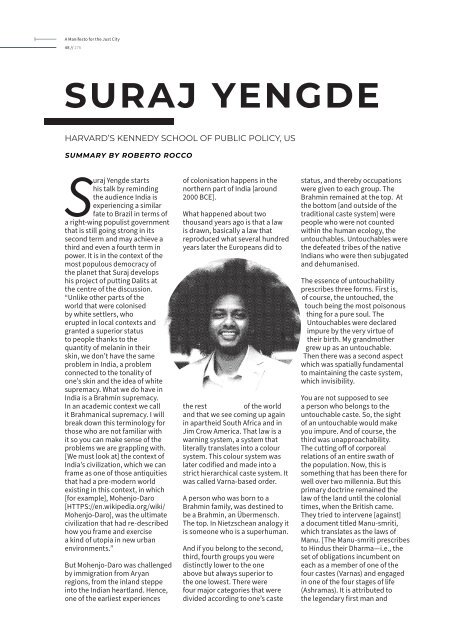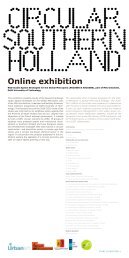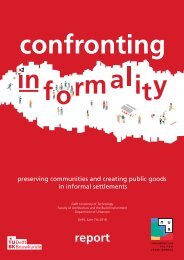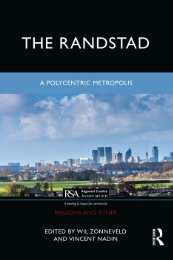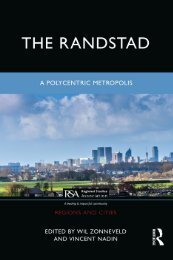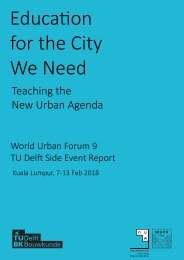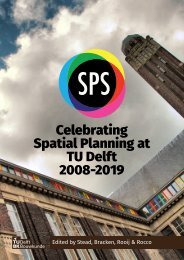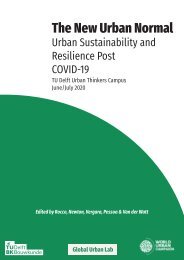A Manifesto for the Just City
On Monday 29 MARCH at 18:00 (CET/Amsterdam), TU Delft launched the Book "A Manifesto for the Just City", with texts by a number of guests and 43 manifestos written by students from 25 universities from all over the world. A “Manifesto for the Just City” comes in the wake of the realisation that socio-spatial justice is a crucial dimension for sustainability transitions. Growing inequality and the erosion of the public sphere undermine the social and political structures required to fight climate change, pandemics and other systemic shocks. With this book, we have sought to encourage students to formulate their own visions for the Just City and for a just transition. This book is result of an Urban Thinkers Campus organised between 9 and 30 November 2020. The Urban Thinkers Campus (UTC) model is an initiative of UN-Habitat’s World Urban Campaign, conceived in 2014 as an open space for critical exchange between stakeholders and partners. It aims to promote debate and action on sustainable and inclusive urbanization upholding the principles and guidelines contained in the New Urban Agenda, launched at Habitat-III in 2016 in Quito, Ecuador.
On Monday 29 MARCH at 18:00 (CET/Amsterdam), TU Delft launched the Book "A Manifesto for the Just City", with texts by a number of guests and 43 manifestos written by students from 25 universities from all over the world.
A “Manifesto for the Just City” comes in the wake of the realisation that socio-spatial justice is a crucial dimension for sustainability transitions. Growing inequality and the erosion of the public sphere undermine the social and political structures required to fight climate change, pandemics and other systemic shocks. With this book, we have sought to encourage students to formulate their own visions for the Just City and for a just transition.
This book is result of an Urban Thinkers Campus organised between 9 and 30 November 2020. The Urban Thinkers Campus (UTC) model is an initiative of UN-Habitat’s World Urban Campaign, conceived in 2014 as an open space for critical exchange between stakeholders and partners. It aims to promote debate and action on sustainable and inclusive urbanization upholding the principles and guidelines contained in the New Urban Agenda, launched at Habitat-III in 2016 in Quito, Ecuador.
Create successful ePaper yourself
Turn your PDF publications into a flip-book with our unique Google optimized e-Paper software.
A <strong>Manifesto</strong> <strong>for</strong> <strong>the</strong> <strong>Just</strong> <strong>City</strong><br />
48 // 276<br />
SURAJ YENGDE<br />
HARVARD’S KENNEDY SCHOOL OF PUBLIC POLICY, US<br />
SUMMARY BY ROBERTO ROCCO<br />
Suraj Yengde starts<br />
his talk by reminding<br />
<strong>the</strong> audience India is<br />
experiencing a similar<br />
fate to Brazil in terms of<br />
a right-wing populist government<br />
that is still going strong in its<br />
second term and may achieve a<br />
third and even a fourth term in<br />
power. It is in <strong>the</strong> context of <strong>the</strong><br />
most populous democracy of<br />
<strong>the</strong> planet that Suraj develops<br />
his project of putting Dalits at<br />
<strong>the</strong> centre of <strong>the</strong> discussion.<br />
“Unlike o<strong>the</strong>r parts of <strong>the</strong><br />
world that were colonised<br />
by white settlers, who<br />
erupted in local contexts and<br />
granted a superior status<br />
to people thanks to <strong>the</strong><br />
quantity of melanin in <strong>the</strong>ir<br />
skin, we don’t have <strong>the</strong> same<br />
problem in India, a problem<br />
connected to <strong>the</strong> tonality of<br />
one’s skin and <strong>the</strong> idea of white<br />
supremacy. What we do have in<br />
India is a Brahmin supremacy.<br />
In an academic context we call<br />
it Brahmanical supremacy. I will<br />
break down this terminology <strong>for</strong><br />
those who are not familiar with<br />
it so you can make sense of <strong>the</strong><br />
problems we are grappling with.<br />
[We must look at] <strong>the</strong> context of<br />
India’s civilization, which we can<br />
frame as one of those antiquities<br />
that had a pre-modern world<br />
existing in this context, in which<br />
[<strong>for</strong> example], Mohenjo-Daro<br />
[HTTPS://en.wikipedia.org/wiki/<br />
Mohenjo-Daro], was <strong>the</strong> ultimate<br />
civilization that had re-described<br />
how you frame and exercise<br />
a kind of utopia in new urban<br />
environments.”<br />
But Mohenjo-Daro was challenged<br />
by immigration from Aryan<br />
regions, from <strong>the</strong> inland steppe<br />
into <strong>the</strong> Indian heartland. Hence,<br />
one of <strong>the</strong> earliest experiences<br />
of colonisation happens in <strong>the</strong><br />
nor<strong>the</strong>rn part of India [around<br />
2000 BCE].<br />
What happened about two<br />
thousand years ago is that a law<br />
is drawn, basically a law that<br />
reproduced what several hundred<br />
years later <strong>the</strong> Europeans did to<br />
<strong>the</strong> rest<br />
of <strong>the</strong> world<br />
and that we see coming up again<br />
in apar<strong>the</strong>id South Africa and in<br />
Jim Crow America. That law is a<br />
warning system, a system that<br />
literally translates into a colour<br />
system. This colour system was<br />
later codified and made into a<br />
strict hierarchical caste system. It<br />
was called Varna-based order.<br />
A person who was born to a<br />
Brahmin family, was destined to<br />
be a Brahmin, an Übermensch.<br />
The top. In Nietzschean analogy it<br />
is someone who is a superhuman.<br />
And if you belong to <strong>the</strong> second,<br />
third, fourth groups you were<br />
distinctly lower to <strong>the</strong> one<br />
above but always superior to<br />
<strong>the</strong> one lowest. There were<br />
four major categories that were<br />
divided according to one’s caste<br />
status, and <strong>the</strong>reby occupations<br />
were given to each group. The<br />
Brahmin remained at <strong>the</strong> top. At<br />
<strong>the</strong> bottom [and outside of <strong>the</strong><br />
traditional caste system] were<br />
people who were not counted<br />
within <strong>the</strong> human ecology, <strong>the</strong><br />
untouchables. Untouchables were<br />
<strong>the</strong> defeated tribes of <strong>the</strong> native<br />
Indians who were <strong>the</strong>n subjugated<br />
and dehumanised.<br />
The essence of untouchability<br />
prescribes three <strong>for</strong>ms. First is,<br />
of course, <strong>the</strong> untouched, <strong>the</strong><br />
touch being <strong>the</strong> most poisonous<br />
thing <strong>for</strong> a pure soul. The<br />
Untouchables were declared<br />
impure by <strong>the</strong> very virtue of<br />
<strong>the</strong>ir birth. My grandmo<strong>the</strong>r<br />
grew up as an untouchable.<br />
Then <strong>the</strong>re was a second aspect<br />
which was spatially fundamental<br />
to maintaining <strong>the</strong> caste system,<br />
which invisibility.<br />
You are not supposed to see<br />
a person who belongs to <strong>the</strong><br />
untouchable caste. So, <strong>the</strong> sight<br />
of an untouchable would make<br />
you impure. And of course, <strong>the</strong><br />
third was unapproachability.<br />
The cutting off of corporeal<br />
relations of an entire swath of<br />
<strong>the</strong> population. Now, this is<br />
something that has been <strong>the</strong>re <strong>for</strong><br />
well over two millennia. But this<br />
primary doctrine remained <strong>the</strong><br />
law of <strong>the</strong> land until <strong>the</strong> colonial<br />
times, when <strong>the</strong> British came.<br />
They tried to intervene [against]<br />
a document titled Manu-smriti,<br />
which translates as <strong>the</strong> laws of<br />
Manu. [The Manu-smriti prescribes<br />
to Hindus <strong>the</strong>ir Dharma—i.e., <strong>the</strong><br />
set of obligations incumbent on<br />
each as a member of one of <strong>the</strong><br />
four castes (Varnas) and engaged<br />
in one of <strong>the</strong> four stages of life<br />
(Ashramas). It is attributed to<br />
<strong>the</strong> legendary first man and


